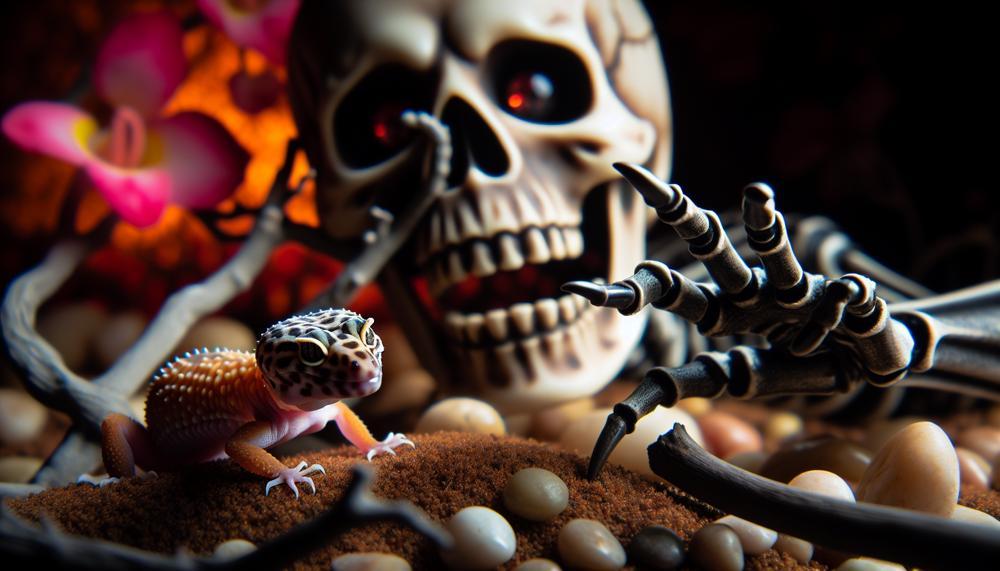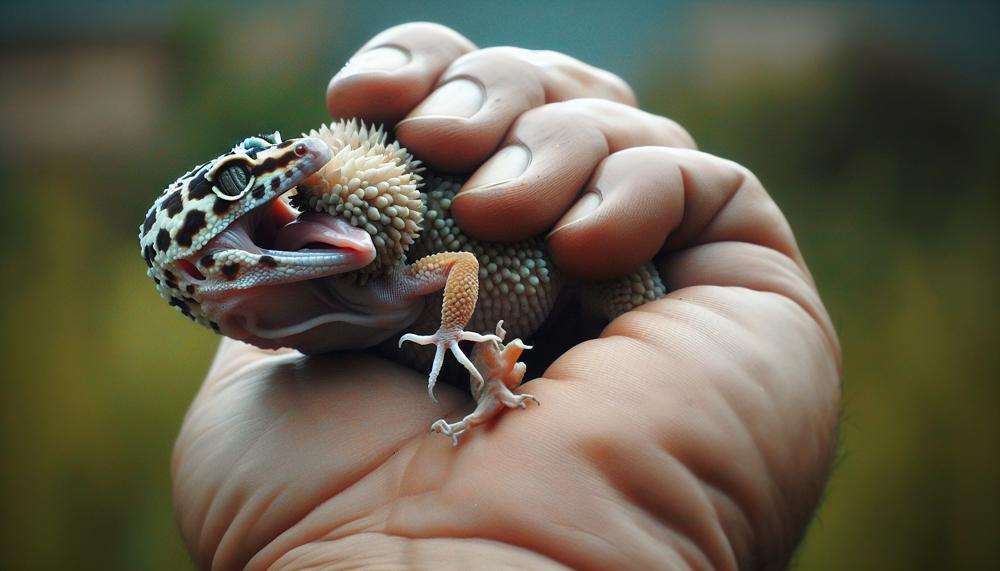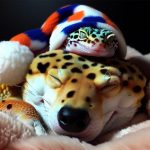Are you a proud leopard gecko parent? Have you ever wondered what happens when these charming creatures meet their end? Prepare to be amazed. Leopard geckos have a curious behavior that sets them apart from other reptiles. They roll over when they die.
In this blog post, we’ll take a closer look at this phenomenon. We’ll unravel its significance for both leopard geckos and their owners.
Grab your favorite snack. Get ready for an enlightening journey into the world of leopard geckos rolling over after death.
- Leopard geckos are no ordinary reptiles, especially when it comes to death.
- Many owners have witnessed their beloved gecko rolling over after passing away.
- This peculiar behavior has sparked intrigue and speculation among reptile enthusiasts.
- But what does it really mean when a leopard gecko rolls over after death?
- Is there something more profound behind this seemingly simple act?
- Join us as we delve into the mystery of this fascinating behavior.
- From scientific explanations to cultural beliefs, we’ll leave no stone unturned in our exploration.
- By the end of this post, you’ll have a deeper understanding of why leopard geckos roll over when they die.
Contents
- 1 What is a death roll and what does it mean?
- 2 Do Leopard Geckos Roll Over When They Die?
- 3 Where did Enigma Syndrome come from?
- 4 How does a leopard gecko get Enigma Syndrome?
- 5 How does the Enigma Syndrome affect your leopard gecko’s brain?
- 6 What are the other symptoms of Enigma Syndrome?
- 7 What can be done to help leopard geckos with Enigma Syndrome?
- 8 Should you breed a leopard gecko with Enigma Syndrome?
- 9 Conclusion
What is a death roll and what does it mean?
The death roll behavior of leopard geckos is a characteristic unique to their species and rarely observed in other animals. Certain reptiles, such as crocodiles, may exhibit a similar rolling motion. However, the underlying cause and significance are different.
Crocodiles use the death roll as a hunting technique. In contrast, leopard geckos typically do the death roll when stressed or sick. It serves as a warning sign that something is amiss and requires immediate attention.
This behavior is significant because it can indicate potential health problems in leopard geckos. Owners can take proactive measures to ensure their pet’s well-being and potentially prevent severe health issues from arising. This is possible by being aware of this behavior and understanding its causes.
Do Leopard Geckos Roll Over When They Die?
Yes, leopard geckos can death roll when they are stressed. Death rolling is a severe symptom of Enigma Syndrome. This neurological disorder affects a gecko’s balance and cognition. Death rolling is a severe symptom of Enigma Syndrome and usually only lasts a few seconds.
To help a gecko that is death rolling, you can:
- Make sure the gecko is on a flat surface
- Remove the gecko from water droplets on the ground
- Keep the environment calm and static
- Avoid bright lights, flashing lights, loud noises, or sudden movements
Other signs that a leopard gecko may be dying include:
- Extreme weight loss
- Lack of droppings
- Lethargy
- Sunken eyes
- Lack of appetite
Leopard geckos can also shed their tails when they feel threatened or in danger. They may also play dead to trick predators.
Where did Enigma Syndrome come from?
Leopard geckos, like many other animals, can suffer from a genetic disorder known as Enigma Syndrome. Unethical breeding practices primarily cause this condition. It can have severe consequences, including death, for affected geckos. In this section, we will delve deeper into the origins of Enigma Syndrome and explore how it came to affect these beloved reptiles.
Irresponsible breeding practices, such as inbreeding and line-breeding, have been linked to the development of Enigma Syndrome in leopard geckos. These practices involve mating closely related individuals. This can result in the passing down of faulty genes. Over time, this can lead to a higher incidence of genetic disorders within a specific bloodline of leopard geckos.
Moreover, some breeders may prioritize physical appearance over the health and well-being of their geckos. This leads to a higher chance of genetic disorders, like Enigma Syndrome, being passed down to offspring. This highlights the importance of responsible breeding practices. They prevent the spread of this disorder.
How does a leopard gecko get Enigma Syndrome?
Enigma Syndrome (ES) is a genetic disorder that affects leopard geckos. It particularly affects those with the Enigma morph and their crosses. This disorder is caused by faulty genetics, often due to irresponsible breeding practices.
Genetics play a significant role in the development of Enigma Syndrome. The disorder is inherited through a dominant gene. It can be passed down from heterozygous or homozygous dominant geckos. This means that even if one parent has the gene, there is a high likelihood of offspring developing ES.
The specific cause of ES is still unknown, but it is believed to be linked to a neurological defect. This defect can result in various symptoms such as head tilting, difficulty catching prey, seizures, and death rolls. These symptoms can range in severity and may worsen over time.
Breeding Enigma Leopard Geckos presents unique challenges. Responsible breeding practices are crucial in promoting the overall health of these reptiles. Breeders must carefully select their breeding pairs and avoid breeding two Enigma geckos together to prevent passing on the dominant gene.
How does the Enigma Syndrome affect your leopard gecko’s brain?
Enigma Syndrome has a profound effect on the brain function of leopard geckos. It results in a range of potential consequences for these reptiles.
Let’s delve deeper into how this condition specifically affects their brain and what owners can do to assist.
Impaired Sensory Functions:
Enigma Syndrome impairs sensory functions in the brain. This can lead to head tilting, difficulty catching prey, and an overall sense of disorientation for the gecko.
Consequently, affected geckos may struggle to locate food and navigate their surroundings.
Seizures:
Enigma Syndrome also significantly impacts the brain; it can cause seizures. These episodes can vary from mild to severe and may cause the gecko to thrash or roll uncontrollably.
Seizures can also result in physical injuries and lead to other health complications.
Behavioral Changes:
Enigma Syndrome can also bring about changes in a gecko’s behavior due to its effects on the brain. Affected geckos may become more agitated, aggressive, or exhibit abnormal movements.
This can make handling them challenging and increase their stress levels.
Potential Consequences:
A gecko with Enigma Syndrome can suffer severe consequences. These include physical injuries due to seizures and a reduced quality of life.
In some cases, ES can even be fatal, making it crucial for owners to provide proper care and management for their affected geckos.
In conclusion, Enigma Syndrome significantly affects the brain function of leopard geckos, leading to various potential consequences such as impaired sensory functions, seizures, and behavioral changes.
It is vital to provide proper care and management for geckos with ES. This ensures their well-being and minimizes the effects of this hereditary disorder. Therefore, it is crucial to stay informed about the latest research on Enigma Syndrome. This helps us understand its impact on leopard geckos’ brain function.
What are the other symptoms of Enigma Syndrome?
Leopard geckos with Enigma Syndrome have an infamous death roll. Several other symptoms can indicate the presence of this neurological disorder. These signs include head tilting, difficulty catching prey, seizures, and changes in behavior.
Head tilting
One common indication of neurological issues in leopard geckos is head tilting, which can also be a symptom of Enigma Syndrome. This can manifest as a persistent tilt to one side or constantly looking up at the ceiling.
Geckos with ES often find it hard to catch prey. The disorder can affect their coordination and depth perception. This makes it challenging for them to accurately catch their food.
Seizures
Seizures are another significant symptom of Enigma Syndrome and can range from mild to severe.
These can include muscle spasms, tremors, and loss of control over bodily functions. In extreme cases, seizures can lead to death due to exhaustion or injury.
Changes in behavior
Changes in behavior are also prevalent among leopard geckos with Enigma Syndrome.
This can include increased aggression towards tank mates or handling. It can also include loss of appetite or lethargy. These changes may be indicative of stress and discomfort caused by the disorder.

What can be done to help leopard geckos with Enigma Syndrome?
There is no known cure for Enigma Syndrome in leopard geckos. However, several treatment options are available to improve their overall health and manage the condition. These include:
- Providing Adequate Calcium and Vitamin D3: Geckos with Enigma Syndrome often suffer from Metabolic Bone Disease (MBD) due to a lack of essential nutrients such as calcium and Vitamin D3 in their diet. Thus, it is crucial to ensure they receive enough of these nutrients to promote bone health and prevent further complications.
- Regular Check-Ups with a Reptile Veterinarian: It is vital to schedule regular check-ups with a reptile veterinarian to monitor the progression of Enigma Syndrome and effectively manage any symptoms. A veterinarian can also offer guidance on the best care practices for your gecko, ultimately improving its overall well-being.
- Close Monitoring of Symptoms: As Enigma Syndrome can lead to various symptoms, it is important to closely observe your gecko for any changes in behavior or physical appearance. This will allow for early detection of complications and prevent them from worsening.
- Creating an Optimal Environment: The environment in which a leopard gecko with Enigma Syndrome lives greatly impacts its health and happiness. Providing an ideal environment with proper temperature regulation, appropriate substrate, hiding spots, enrichment opportunities, feeding methods, handling techniques, and responsible breeding practices is crucial.
These treatment options can be effective in managing Enigma Syndrome in leopard geckos. However, their effectiveness may vary depending on the severity of the condition and each individual gecko’s response to treatment.
Should you breed a leopard gecko with Enigma Syndrome?
Breeding leopard geckos with Enigma Syndrome is not recommended. This is because of the potential risks and considerations involved. These risks include an increased likelihood of passing on the faulty genetics responsible for Enigma Syndrome to offspring. Also, there is a higher risk of breeding with related individuals, which can further increase the chances of genetic issues.
Moreover, offspring can have severe symptoms of Enigma Syndrome. This can happen when they are heterozygous or homozygous dominant. This can have a significant impact on their quality of life.
Conclusion
In conclusion, leopard geckos are not your average reptiles, especially in death.
As devoted caretakers, we have witnessed their unique behavior of rolling over when they pass away. Reptile enthusiasts are curious about this peculiar action. They speculate about what it truly signifies.
Through our exploration, we have uncovered that this death roll serves as a warning sign of potential health concerns. Additionally, it is an indicator of Enigma Syndrome. This hereditary disorder is caused by irresponsible breeding practices.
By investigating the origins and impact of this disorder, we can take proactive steps to ensure the well-being of our geckos. We can also prevent its spread through responsible breeding practices.
We have also learned about the different symptoms. We’ve also learned about treatment options for leopard geckos with Enigma Syndrome. It is crucial for us as pet owners to stay informed and provide proper care for our beloved companions.
However, we must also consider the ethical implications of breeding geckos with known genetic issues. We should prioritize the overall health of the species.






